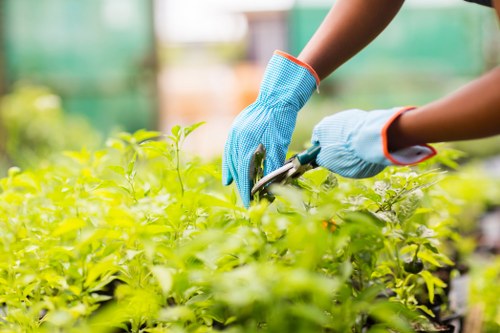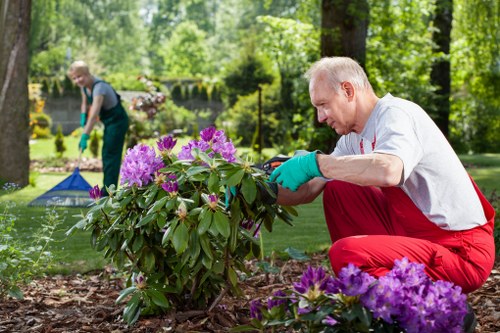Comprehensive Guide to Tree Lopping and Removal in Coney Hall
Introduction to Tree Lopping and Removal

Tree lopping and removal are essential services for maintaining the health and safety of your property in Coney Hall. Whether dealing with overgrown branches, hazardous trees, or landscape redesigns, professional tree services ensure that your trees are managed effectively and safely.
Understanding the difference between tree trimming, pruning, lopping, and removal is crucial. While trimming and pruning focus on the health and appearance of trees, lopping and removal are more intensive processes aimed at mitigating risks and handling problematic trees.
In this guide, we will explore the various aspects of tree lopping and removal, the benefits of hiring professionals in Coney Hall, and what to expect from quality tree services.
The Importance of Tree Maintenance

Maintaining trees is not just about aesthetics; it's also about safety and property value. Overgrown or unhealthy trees can pose significant risks, including falling branches, structural damage to buildings, and even fire hazards.
Regular tree maintenance helps in identifying potential issues early on. By addressing these problems proactively, you can prevent costly damages and ensure the longevity of your trees. Additionally, well-maintained trees enhance the curb appeal of your property, making it more attractive to visitors and potential buyers.
Professional tree lopping and removal services in Coney Hall provide the expertise needed to maintain your trees properly. They use specialized equipment and techniques to handle trees of all sizes, ensuring that the job is done safely and efficiently.
When to Consider Tree Lopping or Removal

Deciding when to lop or remove a tree can be challenging. Here are some indicators that professional intervention is needed:
- Diseased or Dying Trees: Signs of disease, such as leaf discoloration, dead branches, or unusual growth patterns, indicate that a tree may be beyond saving.
- Structural Damage: Cracks in the trunk, split roots, or leaning stems can compromise a tree's stability.
- Overgrown Branches: Branches that interfere with power lines, buildings, or other structures need to be trimmed or removed.
- Hazardous Locations: Trees located near roads, walkways, or high-traffic areas pose safety risks if not properly managed.
- Storm Damage: Trees damaged by storms can become unstable and should be evaluated by professionals.
Timely action can prevent minor issues from escalating into major problems, ensuring the safety and beauty of your property.
Benefits of Professional Tree Lopping and Removal

Hiring professionals for tree lopping and removal offers numerous advantages:
- Safety: Trained arborists understand the risks involved and take necessary precautions to protect your property and themselves.
- Expertise: Professionals can accurately assess the health and stability of your trees, providing informed recommendations.
- Proper Equipment: Specialized tools and machinery ensure that the job is done efficiently and without causing unnecessary damage.
- Regulatory Compliance: Certified tree services are aware of local regulations and obtain necessary permits for tree removal.
- Enhanced Property Value: Maintaining healthy trees improves the overall appeal and value of your property.
Investing in professional services ensures that tree lopping and removal are conducted responsibly and effectively.
Tree Lopping Techniques

Tree lopping involves cutting back the branches of a tree to manage its size and shape. Here are some common techniques used by professionals in Coney Hall:
1. Crown Thinning
This technique involves selectively removing branches to reduce the density of the canopy. It allows more light to penetrate and improves air circulation, promoting overall tree health.
2. Crown Raising
Crown raising focuses on removing lower branches to provide clearance for pathways, buildings, or utilities. This enhances accessibility and reduces the risk of accidents.
3. Crown Reduction
Used to decrease the overall size of a tree, crown reduction involves cutting back branches to lateral branches that can sustain a healthy structure. This method helps in managing tree height without uprooting the entire tree.
Each technique serves a specific purpose and is chosen based on the tree's condition and the client's needs.
Tree Removal Process

Tree removal is a specialized process that involves several steps to ensure it's done safely and efficiently:
1. Assessment
Before removal, professionals assess the tree's health, location, and surrounding environment to plan the best approach.
2. Permitting
In Coney Hall, certain tree removals may require permits. Certified arborists handle the necessary paperwork to comply with local regulations.
3. Preparation
The area around the tree is secured, and any obstacles are removed to create a safe working environment.
4. Cutting
The tree is carefully cut into manageable sections using chainsaws and other equipment, ensuring minimal impact on the surroundings.
5. Removal
Once cut, the tree segments are hauled away, and the site is cleared and restored.
This systematic approach ensures that tree removal is conducted without unnecessary risks or damage.
Environmental Considerations

Tree lopping and removal have environmental impacts that must be considered. Proper practices help mitigate negative effects:
- Sustainable Practices: Using environmentally friendly methods ensures that tree management supports ecosystem health.
- Debris Management: Responsible disposal or recycling of tree waste prevents environmental pollution.
- Preservation of Surrounding Flora: Protecting nearby plants and wildlife habitats during tree operations maintains biodiversity.
Adhering to environmental guidelines promotes the sustainable management of trees and the broader ecosystem in Coney Hall.
Choosing the Right Tree Service in Coney Hall

Selecting a reputable tree service provider is crucial for effective tree lopping and removal. Consider the following factors:
- Credentials: Ensure the company is licensed, insured, and certified by relevant arborist organizations.
- Experience: Look for established companies with a proven track record in handling various tree-related tasks.
- Customer Reviews: Positive testimonials indicate reliable and quality service.
- Safety Standards: The company should adhere to strict safety protocols to protect both workers and your property.
- Transparent Pricing: Clear and upfront pricing without hidden fees ensures trust and satisfaction.
Taking the time to research and choose the right provider ensures that your tree lopping and removal needs are met professionally.
Cost Factors for Tree Lopping and Removal

The cost of tree lopping and removal in Coney Hall can vary based on several factors:
- Tree Size: Larger trees require more time and equipment, increasing the cost.
- Tree Location: Trees in hard-to-reach areas or near structures may necessitate specialized techniques.
- Health of the Tree: Diseased or damaged trees might require more effort for safe removal.
- Additional Services: Services like stump grinding, debris removal, and site restoration can add to the total cost.
Obtaining multiple quotes and understanding what each service includes can help you make an informed decision.
Stump Grinding and Removal

After a tree is removed, the remaining stump can be an eyesore and a potential hazard. Stump grinding and removal are essential steps to complete the tree removal process:
Benefits of Stump Grinding
Grinding the stump prevents pests, such as termites and beetles, from infesting your property. It also eliminates tripping hazards and allows for future landscaping projects without obstruction.
Stump Removal Process
Professionals use specialized machinery to grind the stump below ground level, making it easier to plant new trees or integrate the area into your garden design.
Effective stump grinding contributes to the overall safety and aesthetics of your outdoor space.
Safety Measures in Tree Lopping and Removal

Safety is paramount during tree lopping and removal. Professional tree services implement rigorous safety protocols to protect everyone involved:
- Protective Gear: Workers wear helmets, gloves, safety glasses, and other protective equipment.
- Risk Assessment: Before starting, arborists evaluate the site for potential hazards and plan the operation accordingly.
- Proper Training: Trained professionals understand the correct techniques and procedures to minimize risks.
- Secure Area: The worksite is cordoned off to prevent unauthorized access and ensure the safety of bystanders.
Adhering to these safety measures ensures a smooth and accident-free tree lopping and removal process.
Environmental Impact of Tree Removal

Removing trees can have significant environmental implications. It is essential to balance property needs with ecological responsibility:
Carbon Footprint
Trees absorb carbon dioxide and release oxygen, playing a vital role in mitigating climate change. Removing trees reduces this carbon sequestration capacity.
Biodiversity
Trees provide habitats for various species. Their removal can disrupt local ecosystems and reduce biodiversity.
Soil Erosion
Roots help stabilize the soil. Without them, areas may become prone to erosion, especially in heavy rainfall.
Professional tree services often offer guidance on sustainable practices, such as replanting native species, to offset the environmental impact of tree removal.
Replanting and Landscaping After Tree Removal

After removing a tree, replanting and thoughtful landscaping can restore balance to your property:
Choosing Suitable Plants
Selecting native and drought-resistant plants ensures lower maintenance and better integration with the local environment.
Designing the Space
Incorporating shrubs, flowers, and ground covers can enhance the visual appeal and provide ecological benefits.
Soil Restoration
Amending the soil with compost or other nutrients promotes healthy plant growth and prevents erosion.
Collaborating with professional landscapers can help create a harmonious and sustainable outdoor space.
Regulatory Compliance and Permits

Tree lopping and removal often require adherence to local regulations and obtaining necessary permits in Coney Hall:
- Protected Trees: Some trees may be protected by law due to their age, species, or ecological importance. Removing such trees without permission is illegal.
- Permit Requirements: Depending on the tree size and location, a permit might be required before proceeding with removal.
- Zoning Laws: Regulations regarding property boundaries and land use can affect tree management practices.
Professional tree services are knowledgeable about local laws and handle all necessary paperwork, ensuring that your tree lopping and removal comply with regulations.
Emergency Tree Services

Storms and unforeseen events can cause trees to become hazardous suddenly. Emergency tree services provide prompt responses to mitigate risks:
Timely Response
Rapid assessment and removal of dangerous trees prevent further property damage and ensure safety.
24/7 Availability
Emergency services are available around the clock to address urgent tree-related issues.
Comprehensive Solutions
From immediate removal to cleanup and repair, professional teams handle all aspects of emergency tree management.
Having access to reliable emergency tree services in Coney Hall ensures peace of mind during critical situations.
Frequently Asked Questions

1. What is the difference between tree lopping and pruning?
Tree lopping involves cutting large branches to reduce the tree's size or remove dead sections, often for safety reasons. Pruning is a more precise process aimed at improving tree health and appearance by trimming specific branches.
2. When is the best time to lop or remove a tree?
The ideal time for tree removal or lopping is during the dormant season, typically in late autumn or early spring, to minimize stress on the tree and reduce risks.
3. Can I remove a tree myself?
While small trees might be manageable, it's generally safer and more effective to hire professionals, especially for larger or hazardous trees.
4. How much does tree removal cost in Coney Hall?
Costs vary based on factors like tree size, location, and additional services. It's best to obtain multiple quotes from reputable tree service providers.
5. Do I need a permit for tree removal?
In many cases, especially for large or protected trees, a permit is required. Professional tree services can assist with obtaining the necessary permits.
Conclusion

Tree lopping and removal are critical aspects of property maintenance in Coney Hall. By understanding the processes, benefits, and considerations involved, you can make informed decisions that enhance both the safety and beauty of your environment.
Hiring professional tree services ensures that these tasks are carried out efficiently, safely, and in compliance with local regulations. Whether you're dealing with an overgrown tree, a hazardous situation, or planning landscape improvements, expert assistance can make all the difference.
Contact us today to schedule your tree lopping and removal services and ensure your property remains safe and attractive.

